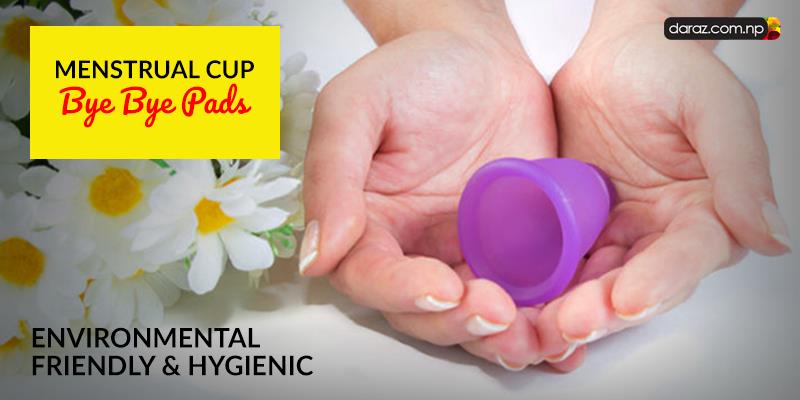Menstrual Cups- Killing Taboo with an Environmental Friendly & Hygienic Option
Many of us have burning questions related to the term Menstrual Cups. What is a Menstrual Cup? A strangely shaped cup that can replace all the conventional sanitary napkins. Yes, you are bound to think that as the only sanitary napkins we have come across are the pads and tampons.
Menstrual cups are the bell-shaped cup with a tip for the better grip of the product. It is a feminine hygiene product that is inserted into the vagina during menstruation. It is mainly utilised purpose is to prevent menstrual fluid (blood from uterine lining) from leaking onto clothes. Most menstrual cups are now manufactured from medical grade silicone because of its durability and hypoallergenic properties, though there are also brands made of TPE (Thermoplastic Elastomer). Menstrual cups are becoming more popular worldwide, with many different brands, shapes and sizes on the market. Most are reusable, though there is at least one brand of disposable menstrual cups currently manufactured.
Unlike the absorption of the menstrual fluid as by sanitary pads and tampons, menstrual cup collects the fluid which can be disposed of as per the convenience. It is placed at the base of the cervix in the vaginal fornix and covers the cervix, like a diaphragm. Because of its placement, It is leakage free. It is not a contraceptive nor does it protect against sexually transmitted infections.
Why Buy/Use It?
- Safer than the conventional sanitary pads and tampons.
- It lasts for 6-12 hours depending on the amount of the menstrual fluid.
- More cost-effective to own a menstrual cup as it is more viable for a reusable option.
- Considered to be more menstrual hygienic for the usage.
- Since reusable, they are more environmentally friendly.
- Less hard on the degradation of the environment and menstrual cups help to reduce solid waste.
How To Use the Menstrual Cups?
Step By Step Instructions are given below:
1. Fold and hold
Always start by washing your hands. Fold the cup using a fold that works best for you. Many starts with the C-fold (as shown in the picture).If that doesn’t work for you, try some of the other folds (as shown in the picture) to make insertion easier. Every menstruating women’s anatomy is unique, so find the fold that works best for you.
2. Insert and ensure

As with tampons, gently insert the folded cup into your vagina, tilting it back to the base of your spine. The cup should sit as low as it can comfortably sit inside your vagina, normally lower than a tampon but with the stem fully inside.
When the cup is inside, it will pop open, creating a light suction. The suction is how the menstrual cup prevents leaks, so use your finger to check if it is fully unfolded. Twist or rotate the cup if you need to.
Don’t rush, take your time – it’s like learning to use contact lenses.
3. Use it up to six to twelve hours
One of the great benefits of using a menstrual cup is that it can be used for up to twelve hours. How often you need to empty your cup depends on your cycle and flow, though most menstrual cup users find they need to empty it only in the morning and again in the evening. It also depends upon the convenience of the user usage.
4. Remove and Empty
With clean hands, gently pull the stem of the cup downwards until you can reach and grip the base of the cup. Pinch the base to release the suction and take it out gently.

You may need to use your pelvic muscles to push your cup lower in the vagina to help you reach the base with your fingers.
When you have removed your cup, empty it into the toilet, and rinse it with warm water.
If you do not have access to water, you can wipe it with some tissue or simply reinsert it directly after emptying it. But make sure to rinse it at your next available opportunity and rinse your menstrual cup.
Menstrual cups may be emptied into a small hole in the soil or in compost piles since the menstrual fluid is a valuable fertilizer for plants and any pathogens of sexually transmitted diseases will quickly be destroyed by soil microbes. The water used to rinse the cups can be disposed of in the same way. This reduces the amount of wastewater that needs to be treated.
5. Re-Insert
When your cup is rinsed, you can reinsert it, and you are ready to go again! Switching from tampons to a menstrual cup is no big deal.
When not in use, store the cups in the carry pouch provided when you buy the product. Be more careful about the storage of the cups, as it is more prone of being infected.
Making the change to another menstrual product is easier than you may think. Using a menstrual cup is very similar to using tampons, just with improved health benefits – no irritation, no chemicals and no drying out.
TABOO IN DIFFERENT CULTURES:
Feminine hygiene products such as menstrual cups that need to be inserted into the vagina can be unacceptable for different cultural reasons. There are myths that they interfere with female reproductive organs and that females lose their virginity. Use of a menstrual cup could stretch or break the hymen. Since some cultures value preservation of the hymen as evidence of virginity, this can discourage young women from using cups.
In rural Nepal, an ancient ritual called “Chaupadi” is still prevalent. Chaupadi is a tradition practised for centuries that banishes females during their menstruation period from the house. Though banned by the Honourable Supreme Court of Nepal in 2004, this ritual is still going on without being curbed by the administration.
But a menstrual Cup manufacturer named Ruby Cup has been active in remote Nepalese villages since 2017. The Ruby Cup has been running campaigns both online and offline to contribute an extra cup to the poor females of rural parts of Nepal every time when someone buys their cup in all platforms (both offline and Online). They have been teaching the users how to correctly use the cups and has been a great impact in terms of health issues faced by the poor females in different areas of the world.
However, slowly and gradually, the views and conception about the usage of the product have been changing through the different kinds of campaigns.


